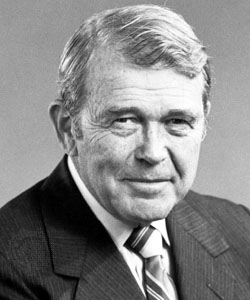
William Redington Hewlett was an American engineer and the co-founder, with David Packard, of the Hewlett-Packard Company (HP).
The William and Flora Hewlett Foundation, commonly known as the Hewlett Foundation, is a private foundation, established by Hewlett-Packard cofounder William Redington Hewlett and his wife Flora Lamson Hewlett in 1966. The Hewlett Foundation awards grants to a variety of liberal and progressive causes.

The Graduate Theological Union (GTU) is a consortium of eight private independent American theological schools and eleven centers and affiliates. Seven of the theological schools are located in Berkeley, California. The GTU was founded in 1962 and their students can take courses at the University of California, Berkeley. Additionally, some of the GTU consortial schools are part of other California universities such as Santa Clara University and California Lutheran University. Most of the GTU consortial schools are located in Berkeley area with the majority north of the campus in a neighborhood known as "Holy Hill" due to the cluster of GTU seminaries and centers located there.
The Pacific School of Religion (PSR) is a private Protestant seminary in Berkeley, California. It maintains covenantal relationships with the United Church of Christ, the United Methodist Church, and the Disciples of Christ, ensuring the school provides the necessary requirements for candidates to seek ordination within these denominations. These three denominations account for approximately half of the student population of PSR. The school has also maintained close relationships with the Unitarian Universalist Association, the Universal Fellowship of Metropolitan Community Churches, the African Methodist Episcopal Church, as well as other denominations. Over the years PSR has provided training for clergy and leaders from a wide range of religious traditions including Buddhists, Jews, Pagans, Pentecostals, and Roman Catholics.

Joseph Esherick was an American architect.

Church Divinity School of the Pacific (CDSP) is an Episcopal seminary in Berkeley, California. It one of nine seminaries U.S. Episcopal Church and a member of the Graduate Theological Union. The only Episcopal seminary located in the Far West, CDSP has, since 1911, been designated the official seminary of the Episcopal Church's Eighth Province, the Province west of the Rocky Mountains.

The Berkeley School of Theology (BST) is a theological school historically affiliated with the American Baptist Churches USA and located in Berkeley, California. It is part of the Graduate Theological Union, a consortium of theological schools and centers in the Berkeley area. BST changed its name from the American Baptist Seminary of the West in July 2020. Prior to that it was called Berkeley Baptist Divinity School.
The Center for Swedenborgian Studies is the seminary of the Swedenborgian Church of North America at the Graduate Theological Union in Berkeley, California. It offers a Certificate in Swedenborgian Studies and a Certificate in Swedenborgian Ministry Studies. It also functions as a think-tank for Swedenborgian studies globally.

The Jesuit School of Theology of Santa Clara University is a Jesuit seminary within Santa Clara University and one of the member colleges of the Graduate Theological Union (GTU) in Berkeley, California. Prior to its merger with Santa Clara University it was known as the Jesuit School of Theology at Berkeley (JSTB).

Northside is a principally residential neighborhood in Berkeley, California, located north of the University of California, Berkeley campus, east of Oxford Street, and south of Cedar Street. There is a small shopping area located at Euclid and Hearst Avenues, at the northern entrance to the university. The Graduate Theological Union is located one block west of Euclid Avenue, in an area nicknamed Holy Hill. The north fork of Strawberry Creek runs southwestward across Northside, mostly culverted under buildings and pavement, to the campus.
Starr King School for the Ministry is a Unitarian Universalist seminary in Oakland, California. It is a member of the Graduate Theological Union (GTU) and is affiliated with the University of California, Berkeley. The seminary was formed in 1904 to educate leaders for the growing number of progressive religious communities in the western part of the US. The school emphasizes the practical skills of religious leadership. Today, it educates Unitarian Universalist ministers, religious educators, and spiritual activists, as well as progressive religious leaders from a variety of traditions, including Christianity, Islam, Judaism, Buddhism, earth-centered traditions, and others.

The Dominican School of Philosophy and Theology (DSPT) is a Catholic graduate school in Berkeley, California. It is a member of the interfaith Graduate Theological Union (GTU) and an affiliate of the University of California Berkeley. DSPT is sponsored by the Dominican Order.
The San Francisco Theological Seminary (SFTS) is a seminary in San Anselmo, California with historic ties to the Presbyterian Church (U.S.A.). SFTS became embedded in a new Graduate School of Theology of the University of Redlands in 2019. It was founded by the Synod of California in 1871.

The Institute of Buddhist Studies is a Jodo Shinshu-affiliated seminary and graduate school, located in Berkeley, California. It is a member school of the Graduate Theological Union, also located in Berkeley. Its mission is to provide graduate level education in the entirety of the Buddhist tradition with specialization in Jodo Shinshu ministry and Buddhist chaplains. It is the sole seminary for ministers serving temples in the United States through the Buddhist Churches of America, the U.S. mainland branch district of the Nishi Hongwanji sect of Japanese Buddhism.
Thomas J. Caulfield was an American architect. Caulfield's work has won numerous national and regional design awards.
John Dillenberger (1918–2008) was professor of historical theology at the Graduate Theological Union in Berkeley, California. He was instrumental in forming the Graduate Theological Union which he headed during its first decade, first as dean from 1964 to 1969 and then, from 1967 to 1972, as its first president, a post to which he returned in 1999–2000. He also served as president of Hartford Seminary, dean of the faculty at San Francisco Theological Seminary, chair of the program in history and philosophy at Harvard University, and as president of the American Academy of Religion.

New College Berkeley is an Gospel-centered, ecumenical graduate school of Christian studies and spiritual formation. It is located near the campus of the University of California, Berkeley and is affiliated with the nearby Graduate Theological Union. The purpose of New College Berkeley is to provide resources to bring God's presence into the public world of work, politics, civic life and academia, as well as the private spaces of discipleship, family and friendship. All of the approximately 200 students each year are enrolled part-time in various courses, seminars and conferences.

The Patriarch Athenagoras Orthodox Institute (PAOI) is a member of the Graduate Theological Union, an ecumenical and interfaith consortium of nine independent seminaries and ten affiliated centers based in Berkeley, California. The institute is a unique, independent, not-for-profit teaching and research institution. The PAOI exists to educate, communicate, promote and sustain the traditions, values, teachings and culture of Eastern Orthodox Christianity. It is the only independent and permanently endowed Orthodox educational center with a physical presence at a North American university.
Flora Lamson Hewlett was an American billionaire philanthropist.
Rabbi Daniel L. Lehmann was the President of the Graduate Theological Union (GTU) in Berkeley, CA from August 1, 2018 until February 2020. Upon his appointment, Lehmann became the first non-Christian to lead the GTU. Previously Lehman served as the eighth president of Hebrew College in Newton, MA and served as the board chair for the Boston Theological Institute.











